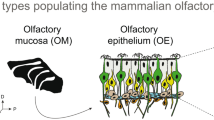Abstract.
The olfactory sense detects and distinguishes a multitude of different odors. Recent progress in molecular as well as physiological approaches has elucidated basic principles of neuronal encoding of odorants, common to insects and vertebrates. The construction of neuronal representations for odors begins with the task of mapping the multidimensional odor space onto the two-dimensional sensory surface, and subsequently onto the olfactory bulb or antennal lobe. A distributed expression of odorant receptors, albeit restricted to subregions of the sensory surface (large, intermediate or small for zebrafish, mouse or drosophila, respectively), ensures a robust representation, insensitive to mechanical insult. Olfactory receptor neurons expressing the same odorant receptors converge to form a receptotopic map in the olfactory bulb or antennal lobe. The emerging coding principle is a chemotopic representation of odorants at the first brain level, realized either as combinatorial or as monospecific representation, depending on the odorant.
Similar content being viewed by others
Author information
Authors and Affiliations
Additional information
Rights and permissions
About this article
Cite this article
Korsching, S. Odor maps in the brain: Spatial aspects of odor representation in sensory surface and olfactory bulb. CMLS, Cell. Mol. Life Sci. 58, 520–530 (2001). https://doi.org/10.1007/PL00000877
Issue Date:
DOI: https://doi.org/10.1007/PL00000877




